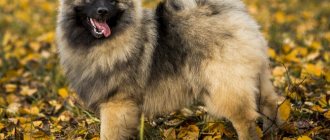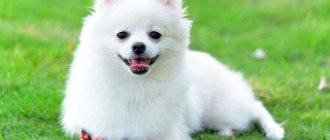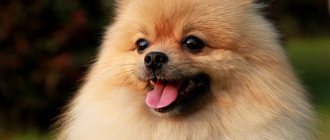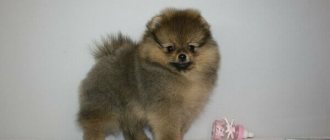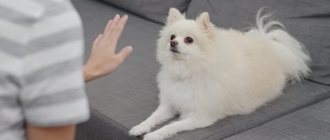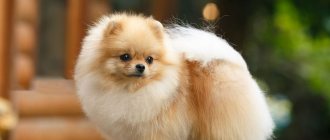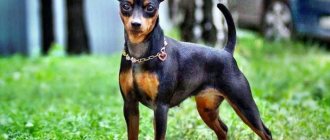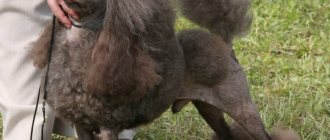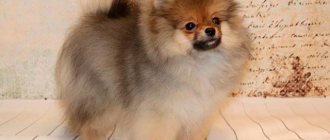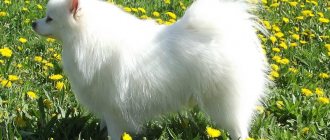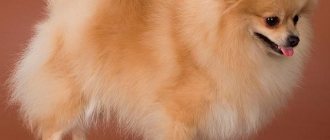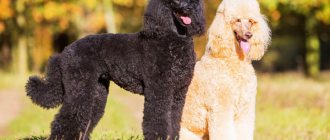Description
The Pomeranian is one of the tiniest breeds in the world. They are true extroverts who boast a kind and affectionate nature. The doggies look like mini foxes. Spitz dogs are easy to train and make excellent watchdogs, as they are cautious and intelligent.
Separate breed or genetic marriage? How is it different from other types?
Mini Pomeranians are not a separate breed . They are distinguished from other types of Pomeranian Spitz by their particularly small stature and fluffy, slightly cottony-looking coat.
Breeders distinguish three types of mini-varieties of oranges - fox, bear and the so-called toy.
This division has not received official recognition, however, most breeders practice this classification because it is convenient for them.
Appearance
— Advertising —
The Pomeranian is a compact, short-haired, active small dog.
An adult animal weighs on average from 1.9 to 3.5 kg and grows to 18-22 cm. The ratio of body length to height at the withers is 1:1.
According to the standard, the animal has the following parameters:
— Advertising —
The head is wide at the back, tapering towards the nose. His facial expression is fox-like, which conveys his alertness and intelligent nature.
The eyes are dark or light, medium size, almond-shaped. Eye rims are black.
The ears are small and set high.
The skull is slightly rounded, but not convex. The muzzle is short and straight. The ratio of the length of the muzzle to the skull is 1/3 to 2/3. The nose is wet and mostly black. Scissor bite.
The neck is well set and of such length that the head can look proud and tall. The chest is oval, tapering.
The back is short, straight and strong.
The tail is set high and lies flat and straight on the back.
Forelegs. The elbow joints are close to the body and positioned straight. The legs, when viewed from the front, are straight and parallel to each other. The height from the withers to the elbows is approximately equal to the height from the ground to the elbow.
Hind limbs. Thighs moderately muscular. The length of the upper thigh and lower leg are equal. The knees are strong, moderately arched and well defined. The legs, when viewed from behind, are straight and parallel to each other. The hock joints, when viewed from the side, are perpendicular to the ground. Otherwise, the hind legs are similar to the forelimbs.
The Pomeranian is a double-coated breed.
There are three different classifications of acceptable pet coat colors. They are divided as follows:
- Red, ginger, cream (beige), sable, sable wolf.
- Black, brown, blue.
- Any other acceptable color and colors. For example, red-sable, black-and-tan, particolor (color), zone-gray, yellow-brown, marbled (merle), blue, peach, milky, snow-white, fawn.
Basic colors
- White. The white dwarf orange should have a snow-white color. No extraneous shades in the form of darkening or yellowing of the coat are allowed.
- Black. A black Spitz should be pure black, with no brown, gray or reddish tints.
- Black and Tan . Jet-black base coat color, complemented by fawn or red markings located above the eyes, on the muzzle, ears, neck, chest, limbs and on the inside of the tail.
- Brown . Can be any of the brownish shades.
- Soboliny . The outer coat is zonally gray in color, and the undercoat is grayish, orange or cream.
- Ginger . It comes in different brightness and intensity: from golden to bright reddish-red. Also, dogs of orange color often have lightening of the fur on the inside of the paws, on the tail and on the neck.
- Cream . It may appear almost red or be difficult to distinguish from white.
- Zonal gray . The guard fur is darkened around the eyes, eyebrows, ears and tail. The undercoat is silver-gray. Due to this, an interesting effect of gradation of fur shades is created, making the orange look like a small wolf.
- Two-color . The main color of the coat is white. There are small markings on it in one of the three colors allowed by the standard: black, reddish or brown.
All other color variations, including merle, blue, tri-color and brown and tan, should be considered breeding grounds..
Pros and cons of a dog
Before making such a friend, study the pros and cons.
Characteristics of advantages:
- The animals are small, so they comply with size restrictions for airplanes and hotels.
- This is an active species. But at the same time, pets can meet most of their needs while indoors.
- Pomeranians are lightweight, making them great pocket dogs.
- Animals don't tend to break things in your home.
- Individuals will not pull you in different directions during a walk, as they do not have enough strength for this.
- The advantage of the breed is that the dog is not allergic.
- They are cheaper to feed, maintain and treat than larger species.
Characteristics of minuses:
- Dogs are fragile. If they jump from a long distance or are stepped on, pets can be seriously injured.
- Purebred Pomeranians are expensive due to their popularity.
- Individuals may be injured by other animals, including some birds.
- Pets shed heavily and therefore require daily care.
- Pomeranians bark a lot, as do many other small breeds.
- The downside is that the dogs are not suitable for families with small children.
- The individuals have one bad habit: they can mark different nooks and crannies of your house. The discharge can smell throughout the entire house, which can be a problem for you.
- Pomeranian owners sometimes tend to succumb to the “small dog syndrome.” This happens when the owners spoil the little dog so much that he believes that he is the head of the family. Remember that individuals can manipulate you.
History of the origin of the breed
Where does the animal's name come from? The fact is that there is a certain territory called Pomerania. It is located on the southern shore of the Baltic Sea and extends to parts of Germany and Poland. Pomeranians take their name from this place because the breed was mainly developed there. Although the origin of the dogs' ancestors is attributed to Iceland.
When you look at your pet, you probably don't imagine him pulling a sled. The small size of the dog does not create the impression of a working animal. However, they are descendants of hard-working dogs from the Arctic climate. Pomeranians were bred from these individuals back in the mid-18th century.
Pomeranians are also related to large, powerful species such as Huskies, Alaskan Malamutes and Chow Chows. Therefore, the personality of a Spitz can often resemble that of a larger dog. Translated from German, “Spitz” means “pointed.”
The small dog we know now used to be much larger. Her weight was approximately 13 kg. The popularity of the Pomeranian has increased several times thanks to some members of the British royal family.
Queen Charlotte (wife of King George III of England) owned two Pomeranians in the mid-1700s. Charlotte took several self-portraits with her Pomeranians. The queen's dogs were larger in size than modern specimens. But at the same time, the pets had similar features. The presence of Pomeranians in paintings has brought greater awareness of these prized puppies to the public.
A century after Queen Charlotte's portrait, her granddaughter Queen Victoria acquired her first Pomeranian. He was tiny and people fell in love with this version of the breed. Queen Victoria was such a fan of these animals that she founded her own breeding nursery. The Queen tried to breed individuals with different coat colors. During her reign, the average size of Pomeranians decreased by 50 percent. The growing popularity of dogs, and especially the miniature version, encouraged breeders to use only small dogs for breeding.
Dog breed recognition
The first club for this breed was organized in England in 1891. Soon after this, a standard for the species was agreed upon and written.
The first appearance of the dog in the United States occurred in 1898. And in 1900, she was recognized by the American Kennel Club.
In 1998, the breed was included in the other German Spitz dog breeds, along with the Keeshond, Giant Spitz, Miniature and Regular Spitz.
Every year the species is included in the top 30 most popular breeds in the world.
Color options
The variety of colors of Pomeranian dwarf Spitz dogs is explained by the variety of nurseries on different continents. There are many colors, not all of them are recognized by the Fédération Cynologique Internationale.
To avoid misunderstandings in determining the correct color of a Pomeranian, you should study the standard colors recognized in all countries. These are white, beige, brown, red and black. Spotted color also has its limitations. Black fawn and gray fawn Spitz dogs are allowed to participate in exhibitions. The white color should not have any spots or impurities at all. A two-color combination of different shades is included in the color standards, but a three-color color is not officially recognized. In the USA, blue, sable, brindle and merle colors are popular, which are not recognized by the FCI and Russian standards for the Pomeranian Dwarf Spitz breed.
Before purchasing a puppy, determine its purpose. A Spitz acquired for exhibition purposes and a companion for the soul require different approaches to choosing a color.
In Russia, several main colors of Pomeranian Spitz are in demand: beige, red, brown, white and black.
Beige dwarf spitz
The cream or beige color of the animal varies in shade and can only differ by half a tone from white. At the other extreme it can be dark beige, almost red or close to light brown.
Dwarf brown spitz
The brown range includes all shades of this color from light to dark chocolate. A special feature of representatives of this color is a brown nose, which is only allowed on brown Spitz. Intense rich chocolate color is valued more than light shades.
Pomeranian dwarf spitz white
The miniature Pomeranian received its main white color back in England under Queen Victoria. Animals of all other colors were bred from him. It’s simply a miracle that the snow-white color did not disappear in the selective pursuit of diversity of the breed and bringing it to micro sizes and has survived to this day in its pure form. The beautiful white Spitz has been popular since the time of Queen Victoria.
A distinctive feature of a dwarf Spitz (mini) dog is its white color without any admixture of other shades.
Types
Fox type
The type standard includes a more elongated and fox-like muzzle than other dog varieties. Imagine a stuffed toy fox with thick, fluffy cheeks, a narrow chin and a button on its nose, and you'll see the appearance of this orange. The standard describes the species' facial expression as having an "alert and intelligent nature."
Bear type
The muzzle of this decorative type is smaller, elongated and flattened, the eyes are round, set close to each other. It seems that the individuals have chubby cheeks. But this is an optical effect that occurs due to the thick hair on the cheekbones. The chin is slightly raised and the tip of the nose is raised.
Toy type
The doll-faced Pomeranian looks the same as the previous type. Therefore, they can be difficult to distinguish. The toy animal also has a shorter, rounder snout and child-like features. But the muzzle has a flatter appearance from above and does not rise upward, compared to a bear cub.
Pomeranian Spitz - photo
Although photographs are not able to convey all the charm of Pomeranians, they also look simply magical. Just look!
Photo: bestcattery.pro
Photo: funart.pro
Photo: smallivingworld.ru
Photo: funart.pro
Photo: pesiq.ru
Photo: klkfavorit.ru
Photo: krasivosti.pro
Photo: zen.yandex.ru Photo: nn.ru
Photo: handler-ulyanova.ru
Photo: k9-forum.ru
Photo: funart.pro
Photo: artfile.ru
Photo: iprofiles.ru
Photo: funart.pro
Photo: belocoon.ru
Photo: spitz-sobaka.ru
Photo: en.spitz.su
Photo: blackmamont.ru
Photo: kot-pes.com
Photo: wallbox.ru
Photo: krasivosti.pro
Photo: mirowo.ru
Photo: en.spitz.su
Photo: otzyvru.com
Photo: krasivosti.pro
Did you like the post? Subscribe to our channel in Yandex.Zen, it really helps us in our development!
Maintenance and care
In general, caring for a pet is not difficult. There are several aspects of care that will make your furry friend feel comfortable and happy.
- Clean and comb your pet's fur. You should do this daily to avoid tangles. You will need a brush or metal comb, which can be purchased at your local pet store.
- Periodically, the dog requires grooming. However, never make your pet completely bald. During grooming, you can order a special type of haircut or hairstyle from a specialist.
- Give your pet a bath. You don't need to do this often, once a month is enough. Wash it with a special shampoo for sensitive skin. Make sure the shampoo does not contain artificial fragrances or colors.
- Perform other maintenance steps as well. You need to cut his nails, clean his eyes, ears, teeth. Trim your nails every one to two weeks to keep them from becoming too long. Clean your eyes and ears daily.
- Walk your pet every day. He will be able to expend his energy through long walks. Dogs also love to play, but playtime is not a substitute for a walk.
- In winter, walk your friend in a special warm overall or suit.
- Regular veterinary visits can help assess your pet's overall health. Periodically do deworming and flea prevention.
- The Pomeranian's anal glands contain a lubricant, just like most dogs. If it is not cleaned periodically, it can lead to serious infections. As a rule, it is recommended to do the procedure once a month. Go to the vet or do it yourself.
- This is a loving dog that needs a lot of attention from its owners. However, this does not mean that animals always enjoy being held. They also prefer people to respect their space.
Briefly about the main thing
- Pomeranian Spitz is a miniature breed of decorative dogs with excellent health.
- The luxurious fur coat consists of a thick undercoat and guard hair - the main feature of the orange.
- They are active, playful, devoted dogs, and when properly trained, are non-aggressive and obedient.
- Pomeranians are prone to dominance and need strict but fair upbringing.
- Attentiveness, sensitivity and distrust make the Spitz a good guard.
Tell us in the comments what difficulties you encountered in raising your Pomeranian?
Did you like the article? Share it with your friends on social media. networks. This will help them get useful information and support our project.
Nutrition
The classic Spitz diet is rich in calories and nutrients. Most of his diet should be of animal origin: meat, poultry and fish. Animal proteins provide the 20 essential amino acids your dog needs. Fats should also come from animal sources. For example, from chicken fat or salmon oil. Dogs do not have specific requirements for carbohydrates in their diet.
Choose a special food for small breeds that contains all nutrients in balanced amounts. Feed the animals 3 or 4 times a day.
Approximate amount of food per day, depending on activity:
- With a weight of 1 – from 24 to 31 g.
- With a weight of 1.5 kg - from 32 to 42 g.
- With a weight of 2 kg - from 40 to 53 g.
- With a weight of 2.5 kg - from 47 to 62 g.
You may need to reduce feedings to twice a day or reduce portions when your Pomeranian reaches 7 to 9 years of age.
Feed
What to feed a Pomeranian Spitz and what kind of food can he eat?
Your dog's diet should have a balance of proteins, carbohydrates, fats and vitamins. Namely, 40% proteins, 30% carbohydrates, 5% fats.
Quality food is more than a recognizable brand. Some of the most well-known brands of food are not suitable for most pets. However, here are some ingredients to look for on the label:
- Meat and meat meal. The most important ingredient in food is protein. However, not every protein will be beneficial for small breeds. Most proteins should come from real meat. This will depend on the brand you choose. Usually, the composition includes chicken or turkey. You will also find other meats such as beef, pork. Proteins should be listed by meat type (chicken, turkey, etc.). The label should not simply say “meat.” The same goes for meat flour. It should be written what kind of meat it is made from. If you see "meat meal" written on it, choose a different brand.
- Vitamins and minerals should come from natural sources such as vegetables and fruits. You can also purchase special vitamin supplements that are beneficial for older individuals.
There are a few things you should watch out for and avoid when choosing food.
- By-products. Meat by-products are food products identified as not being consumed by humans. The raw materials from which the by-product is obtained have no nutritional value and often contain spoiled or rotten meat. It may also contain plastic, polystyrene foam and other types of polymer packaging. By-products include skin, intestines and other parts that are not used for human consumption. Butchers and grocers send expired raw materials for reuse in the production of by-products.
- Artificial colors or other chemicals. Dogs are sensitive to products that contain artificial colors. If you ever see colors on the ingredient list, you should avoid that food. For example, blue 2, red 40, yellow 5 and 6 and so on. These supplements are designed to please human eyes. However, dyes can cause food allergies in your pet.
The dog loves natural homemade food. It is important to take care of the composition of nutrients in it. Include the following ingredients in your pet's diet:
- Proteins: White chicken or turkey (boneless, skinless, baked or fried), lean beef, fish (mackerel, salmon, herring, walleye, flounder), lamb, gizzards (liver, beef, or chicken) and/or pork (should not be the main source of protein).
- Vegetables: peas, carrots, spinach, zucchini, green beans, bell peppers and zucchini. You can also offer asparagus, cabbage, cauliflower and broccoli (in moderation, as these foods can cause gas in the stomach and intestines). Pumpkin can be given in moderation, but it is usually used to relieve symptoms of diarrhea.
- Grains/carbohydrates: include oatmeal, white or brown rice (unless intolerant), quinoa, potatoes.
- Fruits: blueberries, raspberries (both low in calories, high in antioxidants), strawberries, banana, cantaloupe, mango, kiwi, pear, peaches, nectarines, fresh pineapple and apple (no core, no seeds). Dogs can consume watermelon and oranges in moderation.
- Additionally: cottage cheese, white yogurt, eggs (most dogs like scrambled eggs more than boiled eggs).
If you decide to switch from dry food to homemade food, it is important to do it correctly. Changing store-bought food should be done gradually. Better consult your veterinarian.
Avoid the following foods:
- Chocolate.
- Coffee.
- Onion.
- Garlic.
- Raisin.
- Grape.
- Nuts.
- Corn.
- Bones.
- Spicy food.
If for some reason your pet does not eat for more than a day, he may be sick. Contact your veterinarian.
Girl
In general, girls are slightly heavier than boys. The normal weight of a knot is 1.8–2.5 kg.
Many puppy buyers think that female puppies are sweeter, more obedient, attentive, and easier to train than male puppies. This is actually a myth.
The Spitz bitch can be independent, aloof, stubborn and very territorial. Pomeranian women love to dominate family members.
She may become moody and withdrawn during heat. This is partly due to the fact that hormone levels rise and fall sharply.
Mating
Full sexual maturity reaches doggies at 2-2.5 years. After the third heat, the girl is considered ready to give birth to puppies. The best days for mating are considered to be 13-15 from the beginning of the estrus itself. The owner needs to record the beginning of the cycle, its middle and end. Note possible matings and pregnancies. The female flows twice a year (with an interval of 6-10 months), it is better to breed through a cycle so as not to exhaust the girl.
After the start of a new cycle, the owner must contact the breed club to select a candidate for mating. There the dogs are analyzed, their positive and negative qualities and compatibility are compared. The owners sign a contract, receive certificates, and agree on a place and time.
Spitz are small, they don't need much space, but it wouldn't hurt to get some help. Due to their short stature and square format, it is simply uncomfortable for pets to stand, so in the process the female is supported under the belly, and the male by the lower back.
Dogs need time to get to know each other. After 10-15 minutes (if fully prepared), the female will allow mounting. The lock guarantees a positive result, but even if it is absent, pregnancy is not excluded. Mating is repeated after 2 days.
Read a detailed article on the topic: “Everything you need to know about breeding dogs: appropriate age, what to do if it doesn’t work out, rules and tips.”
Boy
The normal weight of a boy is 1.8-2 kg.
Male Pomeranians are usually more assertive, less capricious, attentive and more demanding of attention from their family. They become very attached to their owners.
The boy, in most cases, is easily motivated by praise and food, which makes his learning easier.
All dogs are capable of marking territory. However, males do this more often than females. Boy dogs have a high sense of smell. Therefore, it is not surprising that a male can detect a female during estrus at a distance of up to 5 kilometers. This can encourage the pet to run, as hormones “tell” the dog to follow the female at any cost.
Nicknames
For boy
Popular nicknames for boys:
- Blake.
- Francois.
- Asher.
- Archibald.
- Charleson.
- Duke.
- Kingston.
- Chaucer.
- Darcy.
- Winston.
- Small.
- Gatsby.
- Princeton.
- Oliver.
- Chewie.
- Marley.
- Percy.
- Barki.
For girl
Popular nicknames and names for girls:
- Fifi.
- Queenie.
- Bianca.
- Camilla.
- Effie.
- Chanel.
- Victoria.
- Octavia.
- Juliet.
- Theodora.
- Scarlet
- Stella.
- Sabina.
- Zoe.
- Gertrude.
- Gracie.
- Rozzie.
- Sophie.
- Amelia.
Breeding
It is considered to be a difficult breed to breed. This is associated with the small size of the animal. A girl gives birth to 1-3 puppies at a time.
You must bring together purebred individuals of the breeding class to obtain purebred offspring. The breed-class pet fully complies with the standard. They must also have the appropriate documents: passport and confirmed pedigree.
Introduce the individuals before mating. It is important that the girl is slightly larger than the boy. Make sure your animals have all required vaccinations.
Estrus in females lasts about 22 days and occurs in 2 stages. The most favorable time for mating is after 10-12 days from the beginning of menstruation.
Leave the couple in a separate, quiet room during mating.
The pregnancy of an individual lasts 58-64 days.
For the first three weeks, the bitch may not show any signs of pregnancy. The female may develop toxicosis in the next 10 days. After the 5th week, obvious signs of an interesting position should appear, such as a rounded tummy and swollen nipples.
A girl's temperature may fluctuate during the last week of pregnancy and she will become restless.
Ensure that a veterinarian is present during the birth, especially if it is your female’s first.
Newborn puppies weigh from 55 to 125 g.
How to choose your future pet?
It is best to purchase a puppy in a specialized nursery from trusted breeders who value their reputation - this will eliminate the possibility of buying a purebred or sick pet.
It is important to inspect the living conditions of the dogs, meet the puppy’s parents, find out about their health and titles if we are talking about buying a breed or show-class pet.
It is also necessary to carefully examine the puppy itself. In a healthy standard dog:
- shiny coat without bald patches and dandruff;
- clean skin without rashes, inflammation and scratch marks;
- there is no increased lacrimation, discharge from the nose and eyes;
- ears are clean, without unpleasant odor;
- pink mucous membranes;
- not bloated belly;
- scissor or straight bite.
The puppy must be active, cheerful and inquisitive; aggression is unacceptable.
Reference! The size of the puppy should not determine the choice - even the smallest pet can grow up to be a large dog.
You should also decide in advance about the gender of the dog - its character largely depends on this. So, males are more stubborn and independent, while females are more obedient, more affectionate, and easier to train. In addition, if there are plans for the pet to participate in breeding the breed, then the choice should be a girl.
Puppies
When you arrive home with your new puppy, he or she may be nervous. This is due to the fact that the animal has found itself in a new environment and is away from its loving mother and brothers. Stress may affect some individuals during the first few days.
Make sure your baby eats his food. Too much excitement can cause a young orange to refuse food and become exhausted.
Be sure to take some precautions to create a safe environment for your new family member.
Just because he or she is so tiny and cute doesn't mean the animal won't be interested in everything around it. Most puppies love to chew, especially when they are teething. Don't leave "people food" within your dog's reach. Keep all chemicals in cabinets and close doors after you remove or put anything in.
Be sure to keep trash cans and trash out of your pet's sight and reach. Distract your Pomeranian from being interested in your personal belongings. This can be done by purchasing toys that are appropriate for his size and age.
The best food for Pomeranians is a complete puppy food that is made specifically for small breeds. Toddlers have different nutritional needs than older dogs. And small breeds have different needs compared to large ones. Therefore, it is important to choose the right food for your little friend.
Baby food can be wet or dry. You may have to experiment. This is necessary to find out what your puppy prefers.
Consider the following when choosing food. First, puppies have specific nutritional needs. Calcium and phosphorus are important for bone health and growth.
Secondly, puppies, like adult dogs, need protein and fat. The feed should contain from 22% to 32% protein. Fat should be from 10% to 25%.
Protein helps build tissue and muscle in the body. And fat is a source of energy. Essential fatty acids are also important for healthy skin and coat.
Feed the animals the following amounts of feed, depending on their body type:
- 2 months – from 29 to 71 g.
- 3 months – from 32 to 80 g.
- 4 months – from 33 to 84 g.
- 5 months – from 33 to 84 g.
- 6 months – from 28 to 76 g.
- 7 months – from 24 to 68 g.
- 8 months – from 24 to 60 g.
A puppy needs 3-4 small meals a day. Reduce feeding to 2-3 feedings when he reaches 3 months of age.
Dog character
The Pomeranian's personality is as big as that of larger dogs. Despite the fact that these are small dogs, weighing only 2-3 kg. In general, character traits include: energy, devotion, love, liveliness, sociability, intelligence. Characteristics also include that they are funny and playful.
Animals require a lot of mental stimulation and must always be kept busy. The pets are extremely independent and susceptible to the “small dog syndrome” that is common in many other small dog breeds.
Puppies need a lot of exposure early in life to help them become social and well-behaved.
Pomeranians respond well and enjoy training.
This is an alert breed, acutely aware of environmental changes. They make excellent watchdogs. This is due to the fact that the animals are very alert and also very curious. They enjoy exploring their environment. If possible, pets either peek through the curtains or sit on the windowsill and watch the world go by outside. Your Pomeranian will always bark to alert you if someone is at your front door.
Pets love to be held by their owner. But that doesn't mean they'll want to spend every day sitting on your lap. However, individuals will want to be as close to you as possible.
Most dogs will want to sleep in your bed with you. There, pets feel safe, happy and more relaxed.
These little dogs get along with each other, cats and other animals.
Oranges are tiny and delicate. Their fragile bones can break if handled roughly. Families with small children are not recommended to purchase this look.
Owner reviews
The breed is not at all suitable for owners with a very busy working day. Also, Spitz will not get along with passive, phlegmatic people who do not like activity and walks. Owners cannot talk about the disadvantages of the breed, because they consider Pomeranians to be the cutest creatures.
- Kirill (Moscow):
“We bought a dog for my wife, we didn’t have any extra financial resources, so we chose it without plans for a show career. The puppy was taken without flaws, good pet class, but with a pedigree. It turned out to be a living dog that met all the characteristics of the standard. Very active, friendly, cheerful, barks loudly, and guards the apartment well. There are no problems with care, all procedures are standard, the dog tolerates bathing and haircuts. Wool, of course, falls out almost all year round, so we try to comb it more often.”
- Ekaterina (city of Kemerovo):
“We dreamed of a Spitz for a long time, we bought not the standard one, but the bear type, but this prevents him from being a super star in the city. There are absolutely no cons. A flexible, affectionate dog, he just barks loudly. Doesn't really like strangers, but quickly gets used to them, easily follows and remembers commands. We feed him dry food, pamper him with fruits and vegetables, the pet is not picky.”
- Elena (Latvia, Riga):
“My red fox is the most flexible animal, but only within the family. The Pomeranian is affectionate, kind, loves her relatives, but is jealous of all other pets and strangers. Barks frequently and reacts to all noises outside the door. She’s very cheerful and active, she runs with me in the morning, she behaves well and restrained when traveling.”
Spitz are not just little lumps that look like toys. In fact, these dogs are too active and loving; not all owners will like their pets’ excessive positivity and constant readiness to play. It is important to select a puppy not only based on external data, but also according to the breed standard of character traits.
5 / 5 ( 5 votes)
Education and training
Here are some tips for raising a Pomeranian:
- Be firm and consistent to develop the right habits in the species. Start training and education as early as possible. Although pets are eager to learn new things and please you, they are sometimes very independent. Poorly trained dogs can develop what is called “small dog syndrome.” In this case, the pet believes that he is the leader. Don't let the dog manipulate you. This syndrome can lead to serious behavioral problems throughout life.
- It is important to house train your puppy. It can take up to several months for your baby to get used to the toilet. Be patient with your friend as he is just learning. It is best to train your pet to go outside and let him choose his own place.
- Spitz barks a lot and have a surprisingly loud bark. This makes them excellent watchdogs. However, individuals do not always know when to stop doing this. It is important to teach your pet not to bark constantly. Training begins with training the animal to bark on command. Say a short verbal command “voice” and let your pet bark several times. Hold the treat in front of your nose. Give it to your dog when he stops barking. Command him to stop barking (“quiet”) when your Pomeranian responds to the “voice” command. After several repetitions, your pet should learn this word.
- Animals want to learn new things and develop. They also love to be the center of attention. Therefore, teaching your dog new tricks will make him happy! There are many interesting things you can teach your pet. For example, “play dead,” “grab paw,” and “play kiss.”
Diseases
Pomeranians are generally a healthy and long-lived breed. Although they rarely get sick, pets do have some common health problems.
Obesity is one of the most common problems. Animals do not need much food due to their small size. Therefore, the species is easy to overfeed. Be careful with your portion sizes and calories to prevent obesity.
Dogs are prone to problems with teeth and gums. These include tartar and plaque. Your pet can develop gingivitis or other gum disease if plaque is not removed promptly. This leads to premature tooth loss. Therefore, it is important to constantly keep your mouth clean.
Individuals are also prone to allergies to the environment, nutrients, and much more. Symptoms: the dog’s eyes are watery, he is constantly itching, sneezing, and occasionally coughing. Seek help from a specialist.
Other common problems include:
- Hypoglycemia. Hypoglycemia occurs when blood sugar levels suddenly drop. This most often happens to puppies under 3 months of age or small breeds of dogs. Symptoms: the pet is shaking, trembling, lost appetite, coordination is impaired, and convulsions appear. Pomeranian owners should keep honey in their home. Give your pet honey if he shows the above-mentioned signs. Take your dog to the vet for professional treatment.
- Baldness (alopecia). The condition mainly affects males and often occurs in old age. Symptoms: Your pet is gradually going bald. Baldness starts at the back of the thighs and moves up the back. As soon as you take your baby into your home, familiarize yourself with the symptoms of hair loss in a Pomeranian. Early detection of such a problem is the main factor for proper prevention and recovery.
- Cataract. Cataracts are one of the most common problems that affect the eyes of dogs. Small species are more susceptible to this health problem compared to larger ones. There are many different forms of cataracts. They can develop for various reasons and appear at any age. Symptoms include changes in eye color (appearance of a gray or white coating), swelling or redness of the eyes, and running into walls or other objects due to blurred vision. If you suspect your Pomeranian has cataracts, contact your veterinarian for help.
- Tracheal collapse. A broken trachea is a common problem in the species. The trachea (breathing tube) is supported by rings that are made of cartilage. In small breeds, cartilage is more susceptible to injury. Although this condition can be linked to genetics, it can be prevented in some cases. Symptoms: the pet is coughing, wheezing, and breathing heavily. If you suspect your pet has a collapsed trachea, take him to the vet. In some cases, the problem can be eliminated with medication. In very serious cases, surgery is performed to stabilize the breathing tube.
To prevent common breed diseases, do some simple things:
- Choose your pet's food carefully. Feed your pet the highest quality food. Avoid chemicals or additives that may cause skin reactions, allergies or gastrointestinal problems.
- Train your dog every day. Take your pet for a walk or play at least twice a day.
- Take your dog to the vet for a checkup once a year. Take your older pet to a veterinarian every six months.
- If you can't solve a health problem at home or aren't sure what type of condition your pooch is suffering from, don't hesitate to call your doctor.
- Make sure your Pomeranian receives all required vaccinations.
- For walks, use a special harness instead of a leash. This will help prevent neck injuries or damage to the trachea.
Interesting Facts
- Two Pomeranians were rescued from the Titanic. The information states that along with the approximately 2,240 people who boarded the Titanic, there were also 12 dogs. Unfortunately, only three dogs survived the accident: one Pekingese and two Pomeranians. One specimen was named Lady and belonged to Margaret Bechstein Hayes. The girl was returning from a trip to Europe with her friends. The other pet's name was Jane Ann. It belonged to Martina Rothschild, the wife of a clothing magnate.
- Dogs were popular among artists and musicians. Mozart's biography says that he dedicated one of the arias to his Pomeranian Spitz, Pimperl. Frédéric Chopin, inspired by his friend's tail-chasing, wrote "Waltz of a Dog." When Michelangelo painted the Sistine Chapel, his Pomeranian sat below on a satin cushion, watching what was happening.
- A dog named Jiff set a Guinness World Record for "Fastest Dog on Two Legs" in 2014. The Californian puppy ran 10 meters on his hind legs in 6.56 seconds and five meters on his front legs in 7.76 seconds. Unfortunately, Jiff's status as a top dog did not last long. Soon after, a dog named Conjo broke his record. The five-meter run on his front paws took him 2.39 seconds.
- Many dog breeds come in one or two colors, while others come in four or five. Pomeranians have 23 color combinations that are officially recognized by the American Kennel Club.
- Many puppies change color as they grow older. For example, a cream-colored animal may end up being brown and white, while a brown dog may end up being bright orange. It is impossible to know in advance whether the puppies will change colors.
- A beautiful Pomeranian named Boo has received over 17 million likes on Facebook. He also has over 618,000 followers on Instagram.
- There are more than 30 types of Pomeranians crossed with other breeds. These crossbreeds are called Pom-A-Poo, Yoran, Paperansky, Pomger, Pomston, Shiransky and so on.
- US President Theodore Roosevelt had a Pomeranian. It is said that the man often carried this pocket friend with him, which was called "Jewel".
- Pets love to run. They also like to run in circles. This is normal Pomeranian behavior. A healthy animal can accelerate up to 20 kilometers per hour.
